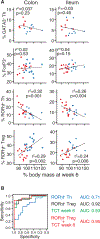Microbiotas from Humans with Inflammatory Bowel Disease Alter the Balance of Gut Th17 and RORγt+ Regulatory T Cells and Exacerbate Colitis in Mice
- PMID: 30650377
- PMCID: PMC6512335
- DOI: 10.1016/j.immuni.2018.12.015
Microbiotas from Humans with Inflammatory Bowel Disease Alter the Balance of Gut Th17 and RORγt+ Regulatory T Cells and Exacerbate Colitis in Mice
Abstract
Microbiota are thought to influence the development and progression of inflammatory bowel disease (IBD), but determining generalizable effects of microbiota on IBD etiology requires larger-scale functional analyses. We colonized germ-free mice with intestinal microbiotas from 30 healthy and IBD donors and determined the homeostatic intestinal T cell response to each microbiota. Compared to microbiotas from healthy donors, transfer of IBD microbiotas into germ-free mice increased numbers of intestinal Th17 cells and Th2 cells and decreased numbers of RORγt+ Treg cells. Colonization with IBD microbiotas exacerbated disease in a model where colitis is induced upon transfer of naive T cells into Rag1-/- mice. The proportions of Th17 and RORγt+ Treg cells induced by each microbiota were predictive of human disease status and accounted for disease severity in the Rag1-/- colitis model. Thus, an impact on intestinal Th17 and RORγt+ Treg cell compartments emerges as a unifying feature of IBD microbiotas, suggesting a general mechanism for microbial contribution to IBD pathogenesis.
Copyright © 2018 Elsevier Inc. All rights reserved.
Conflict of interest statement
DECLARATION OF INTERESTS
D.G. and A.D. are employees of Janssen Research & Development LLC. J.B. is on the scientific advisory boards of Prolacta Bioscience, Inc. and Janssen Research & Development LLC. J.J.F. is on the scientific advisory board of Vedanta and is a consultant for Janssen Research & Development LLC.
Figures





Comment in
-
Defining Dysbiosis in Inflammatory Bowel Disease.Immunity. 2019 Jan 15;50(1):8-10. doi: 10.1016/j.immuni.2018.12.028. Immunity. 2019. PMID: 30650382
-
The gut microbiome: a novel cardio-metabolic target?Cardiovasc Res. 2019 Jul 1;115(9):e82-e84. doi: 10.1093/cvr/cvz151. Cardiovasc Res. 2019. PMID: 31230082 No abstract available.
Similar articles
-
Defined microbiota transplant restores Th17/RORγt+ regulatory T cell balance in mice colonized with inflammatory bowel disease microbiotas.Proc Natl Acad Sci U S A. 2020 Sep 1;117(35):21536-21545. doi: 10.1073/pnas.1922189117. Epub 2020 Aug 18. Proc Natl Acad Sci U S A. 2020. PMID: 32817490 Free PMC article.
-
Microbial-derived bile acid reverses inflammation in IBD via GPBAR1 agonism and RORγt inverse agonism.Biomed Pharmacother. 2024 Dec;181:117731. doi: 10.1016/j.biopha.2024.117731. Epub 2024 Dec 9. Biomed Pharmacother. 2024. PMID: 39657506
-
RORγt Promotes Foxp3 Expression by Antagonizing the Effector Program in Colonic Regulatory T Cells.J Immunol. 2021 Oct 15;207(8):2027-2038. doi: 10.4049/jimmunol.2100175. Epub 2021 Sep 13. J Immunol. 2021. PMID: 34518282 Free PMC article.
-
Interrelatedness between dysbiosis in the gut microbiota due to immunodeficiency and disease penetrance of colitis.Immunology. 2015 Nov;146(3):359-68. doi: 10.1111/imm.12511. Epub 2015 Sep 7. Immunology. 2015. PMID: 26211540 Free PMC article. Review.
-
The Function and Role of the Th17/Treg Cell Balance in Inflammatory Bowel Disease.J Immunol Res. 2020 Dec 15;2020:8813558. doi: 10.1155/2020/8813558. eCollection 2020. J Immunol Res. 2020. PMID: 33381606 Free PMC article. Review.
Cited by
-
Toward a porcine in vivo model to analyze the pathogenesis of TLR5-dependent enteropathies.Gut Microbes. 2020 Nov 9;12(1):1782163. doi: 10.1080/19490976.2020.1782163. Epub 2020 Jul 25. Gut Microbes. 2020. PMID: 32715918 Free PMC article.
-
Immune chromatin reader SP140 regulates microbiota and risk for inflammatory bowel disease.Cell Host Microbe. 2022 Oct 12;30(10):1370-1381.e5. doi: 10.1016/j.chom.2022.08.018. Epub 2022 Sep 20. Cell Host Microbe. 2022. PMID: 36130593 Free PMC article.
-
Cellular and Molecular Roles of Immune Cells in the Gut-Brain Axis in Migraine.Mol Neurobiol. 2024 Feb;61(2):1202-1220. doi: 10.1007/s12035-023-03623-1. Epub 2023 Sep 11. Mol Neurobiol. 2024. PMID: 37695471 Review.
-
Microbiota therapy acts via a regulatory T cell MyD88/RORγt pathway to suppress food allergy.Nat Med. 2019 Jul;25(7):1164-1174. doi: 10.1038/s41591-019-0461-z. Epub 2019 Jun 24. Nat Med. 2019. PMID: 31235962 Free PMC article.
-
Strategies to Dissect Host-Microbial Immune Interactions That Determine Mucosal Homeostasis vs. Intestinal Inflammation in Gnotobiotic Mice.Front Immunol. 2020 Feb 18;11:214. doi: 10.3389/fimmu.2020.00214. eCollection 2020. Front Immunol. 2020. PMID: 32133003 Free PMC article. Review.
References
Publication types
MeSH terms
Substances
Grants and funding
- P30 CA016087/CA/NCI NIH HHS/United States
- T32 DK007180/DK/NIDDK NIH HHS/United States
- R01 CA190400/CA/NCI NIH HHS/United States
- F30 DK108487/DK/NIDDK NIH HHS/United States
- UL1 TR000124/TR/NCATS NIH HHS/United States
- P30 CA016042/CA/NCI NIH HHS/United States
- R01 GM108505/GM/NIGMS NIH HHS/United States
- F31 DK112679/DK/NIDDK NIH HHS/United States
- UL1 TR001881/TR/NCATS NIH HHS/United States
- U24 AI118644/AI/NIAID NIH HHS/United States
- P30 DK041301/DK/NIDDK NIH HHS/United States
- R01 DK085691/DK/NIDDK NIH HHS/United States
- P01 DK046763/DK/NIDDK NIH HHS/United States
- P50 AT008661/AT/NCCIH NIH HHS/United States
LinkOut - more resources
Full Text Sources
Other Literature Sources
Medical
Molecular Biology Databases

